Menus
- Triumph Tiger 800 XR for Road / Route and 800 XC for Cross / Chemin
- False twins, real seductresses
- False twins, real seductresses
- Discovery
- In the saddle
- In the city
- Motorway and expressways
- Departmental
- All Way
- Part-cycle
- Braking
- Comfort / Duo
- Consumption
- Conclusion
- Colors
- XRx Xcx equipment (table)
- Accessories price
Triumph Tiger 800 XR for Road / Route and 800 XC for Cross / Chemin
False twins, real seductresses
Ah the Triumph Tiger … in XR, XC but also XRx and XCx versions! The false binoculars from across the Channel are back in the "x" version. And unlike the actresses of films, they cover themselves more, both in part cycle and in electronics.. Road trips or off-road, the two Tigers cultivate their difference.
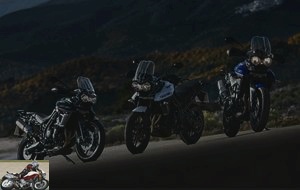
False twins, real seductresses
Released in the wild since 2010, the Tiger 800 and XC have conquered respectable territory on the midsize trail market. Careful aesthetics and manufacturing, overall comfort and dynamic three-cylinder engine, the English wader had seduced and was available in two complementary machines, the XC being even more dedicated to off-road excursions. However, this high potential market is attracting more and more attractive predators, eager to carve out the lion’s share. We will obviously mention the BMW F 800 and 700 GS, both also pairing.

For 2015, Triumph is reviewing its trails, naming them now 800 XR and 800 XC (Road / Cross – Route / Chemin) and also offers, for each, its over-equipped "x" version. It is the latter that we are testing. In the end, the clan goes to four individuals for ever more versatility. Without revolution, the manufacturer of Hinckley refines its concept, in particular in part-cycle, electronic assistance and equipment. Developments which we will judge on the sinuous layout of the Spanish roads and off asphalt, around Malaga.
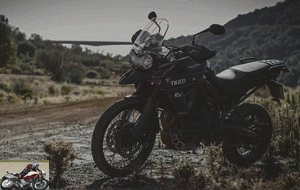
Discovery
Slender, dynamic, the Tiger 800, changes not aesthetically, uniting finesse and power. The main physical difference concerning the side scoops. More prominent, they develop the build of the trail and their upper part is now painted in machine tones. They must also extract calories from the English block more efficiently. Capped with a height-adjustable bubble ("x" version), the sharp double optic is still framed by angular elements stretching over the 19-liter tank. They unite at the front into a spoiler, short on the XRx and longer on the XCx. This is the most obvious detail to differentiate them. But, very similar, the two Englishwomen are indeed false twins. Before listing their difference, let’s talk about their similarities.

Unchanged, rear loop in tubular steel trellis and frame with double spars are adorned with a titanium color. Now mattified, the engine surfaces contrast nicely. These housings still feature a discreet design and are adorned with (superb) new emblems.
Cables and hoses remain fairly skillfully integrated. Unfortunately still welded to the structure, the passenger footrest supports may be expensive in the event of a fall. The more so as, also fixed at their end, the optional luggage elements will increase the lever arm … At their side, the heat shield of the exhaust silencer becomes black while, retaining style and elegance, the swingarm aluminum remains the same.
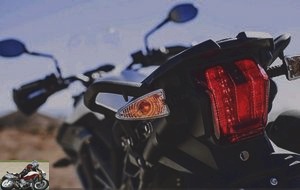
The 800 cc, twin ACT, 12-valve three cylinder receives small but many improvements. New injectors, new camshaft profile optimizing valve lift whose return springs are borrowed from the Daytona. It also lends its selection mechanism to the Tigers, for more precision. Improved, the air box ensures a better flow, Triumph thus announcing 17% of additional autonomy (+80 km is maximum 438 km theoretical). And a new reduced inertia alternator equips the Tigers. We especially note a Ride by Wire necessary for the advanced functions of on-board computers and electronic assistance. The English block thus offers several engine maps (Sport, Road, Offroad and Rain) in order to adapt more finely to driving conditions. Its power is still 94 hp (70 kW) at 9,250 rpm for a torque of 7.9 da.Nm at 7,850 revolutions / minute and an identical bore / stroke ratio, 74×61.9 mm. Anti-slip (TTC) like ABS, (now standard on all Tiger and can be deactivated) present on the "x" an Offroad mode. The traction control then authorizes drifts of the rear wheel and suspends the anti-locking of the latter but only reduces that of the front. Finally, three driving modes combine this beautiful set. Road configures ABS, TTC and mapping by default, Offroad reduces assistance intervention as above and adjusts throttle and Rider lets the rider combine their own preferences. Radially mounted, the two-piston Nissin front calipers squeeze 308mm rotors while the opposing clamp bites a 255mm disc.

Let us now focus on studying the specificities of the two sisters and in particular their cycle part. The most road-going, Xrx, has Showa suspensions: 43 mm inverted fork, unfortunately not adjustable and single-shock absorber adjustable in preload, with respective travel of 180 and 170 mm. The rims, 19 and 17 inches, with five split spokes are made of aluminum and shod with Pirelli Scorpion Trail in 100/90 and 150/70. Already superior to the basic versions, the range of accessories is enriched more specifically by a comfort saddle for the crew (3D mesh) and an adjustable windshield.
The XCx ensures its all-terrain claims by acquiring a WP equipment. 43 mm inverted front element (Showa 45 mm on previous XC), adjustable in rebound and compression, offset reservoir mono-shock absorber adjustable in preload and rebound, the first sliding on 220 and the other 215 mm. Spoked, the wheels display characteristics adapted with their dimensions of 21 and 17 inches and adopt Bridgestone BattleWing in 90/90 and 150/70. The equipment also follows the offroad route, with an enveloping aluminum belly pan and tubular side guards.
And moreover, these "x" have in common, central stand, handguards, cruise control, automatic stop indicators and second 12 Volts socket (under the saddle, left side)…. a truly complete package! We regret all the same that the more road does not have any device for adjusting its fork..
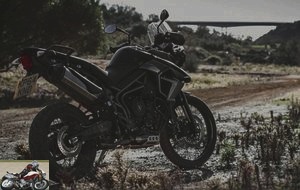
In the saddle
Perched on the machines, we are immediately seduced by the comfort of the English trails, associated with ergonomics studied and readjusted for this new opus. Depending on their ability, weight, saddle height and handlebar position differ between the two models. The more road-going Tiger announces 216 kg when the more adventurous accuses 5 more, ready to travel. Narrow and easily adjustable in height by lowering a plate, the seats remain particularly accessible, varying from 810 to 830 mm for the XRx and 840 to 860 mm for the XCx. These values are further reduced by 20 mm with the low seat option (790 / 810mm and 820/840 mm). Under the passenger cushion, there is still a correct storage space (2.75 L), accepting a small U-lock. The large but thin grab handles receive discreet lugs. They are combined with the small luggage carrier extending the saddles, optimizing the transport of various objects. As for the variable-diameter handlebar, that of the XC is advanced by 5.5 mm and rests on perforated bridges, 20 mm higher, ensuring better guidance in any terrain. The hydraulic adjustment knobs, at the top of the WP fork tubes, are easily manipulated by hand; Relaxation on the left, compression on the right. The entire triple tree is of rewarding quality. The rubber of the rider’s footrests is removable, thus ensuring more grip for the Offroad. Naturally, the reduced leg flexion also contributes to the ease of the crew on both machines.
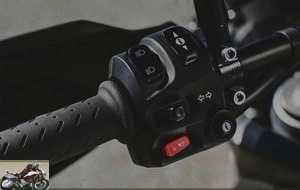
Imposing, the controls easily accommodate the many pushbuttons directing the electronics and the levers are adjustable in spacing. Sober, well finished, the cockpit houses a standard Triumph instrument cluster. Clear, legible, the analog tachometer stands alongside a large digital window. Tachometer, gear indicators, driving mode icons, fuel gauges, engine temperature and clock are displayed. Our top-of-the-range "x" versions have additional functions and, via the two "Info" buttons, scroll through speed and average consumption, outside temperature, range and journey time, all linked to two partials. And alongside the right handle, the "x" versions offer a speed regulator, unheard of in this segment..

Two Warning and M (Mode) keys are directly accessible at the end of the instrument panel, the latter allowing rapid modification of assistance configurations (ABS and TTC) and engine maps. For the latter, Road lets the mechanics express themselves by default, Sport gives a more frank throttle response, Offroad adapts it to off-road conditions and Rain more gently regulates the arrival of power. It is then necessary to disengage and shut off the throttle to validate.
The whole lacks a little practicality to modify in detail the desired values but remains consistent on a daily basis. We appreciate the contrast of the screen, readable on any occasion as well as the presence of the main 12 Volts socket, near the transponder switch. Additional lights and heated grip are available as an option but their control buttons lack integration.

In the city
Bad hair, the Tiger always wakes up by whistling but, from mid-revs, more pleasant rumblings cover these murmurs. Moreover, less heady than those of block 675. The 800 boiler still shows as little inertia to increase in speed, auguring a behavior of the most pleasant.
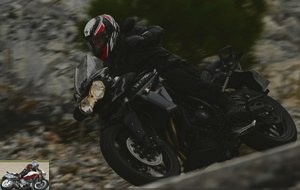
From the first meters, the differences in the chassis are obvious, resolutely separating the sisters of Hinckley. With these suspensions dedicated to adventurous excursions, the XCx swallows all the faults, whatever the rolling surface. It is even as comfortable, without a comfortable saddle, as its twin. Corollary of these long legs, it plunges noticeably when braking. The XRx is logically more in its business between the walls, its equipment following the urban dictate better. However, both accept these narrow evolutions without difficulty, emphasizing their handling. Thus, the U-turns are easily done, the trails displaying a reduced turning radius. When maneuvering, we will still take care of the high perched masses..
The approval also applies to the discreet operation of the Ride by Wire. Devoid of jerks, he gently seconds the pilot’s injunctions. Likewise, the selection is just as clear and the clutch (cable) requires little effort. The whole is satisfactory in town, giving the machines a lot of ease in traffic. However, these backpackers deserve to leave the urban cage.
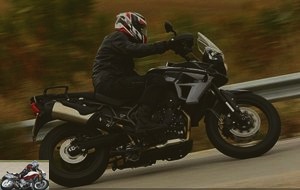
Motorway and expressways
Loving to roar over a wide range of engine revs, the Tigers throw themselves without downtime towards the horizon. In legal cruising, XRx and XCx demonstrate their difference. The first provides better protection thanks to its adjustable screen. Narrow, it certainly leaves the shoulders in the grip of the air flow but effectively deflects the air pressure to the top of the helmet. On the other Albion, you can feel the elements more and, in the rain, the original window will quickly be out of date..
Stabilized at 6000 rpm, the English block only asks to take off at this speed. Light tingling gently invades the footrests, increasing reasonably with the pace. Even on the last report, the revivals are then vigorous and propel the machines towards the double hectokilometer / hour. To secure your license, you will use the cruise control system. Its simple implementation is cut by pressure on the levers or forward rotation of the throttle grip. Stable, midsize trails are pleasant and comfortable on the road. However, their mischievous motorization calls for play areas more conducive to their agility..
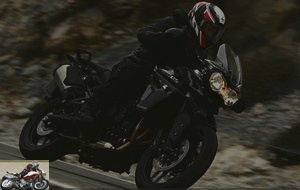
Departmental
While the more road asserts the approval of a smaller front wheel, the other reduces this handicap by a narrower tire. Less precise, the XCx thus retains good agility on the road. Her sister flaunts hers. Bouncing on the Iberian curves, the XRx goes from one angle to another like a slender metronome beating a prestissimo tempo. The rigidity of its frame and the large lever arm of the handlebar help to chain the ferrule at high speed. The rhythm ends up finding the (distant) limits of the ground clearance of one and the other.
Although devoid of adjustment, the steering gear of the XRx finely apprehends the defects of the bitumen. The well-controlled damping limits diving during decelerations and the road trail ensures more than engaging handling.
However, the road feel of the WP elements of the XCx is a pleasure. In more relaxed piloting, we appreciate the damping capacities of its adjustable hydraulics. And, in spite of greater deflections, its optimization capacities have a significant influence on its road behavior..
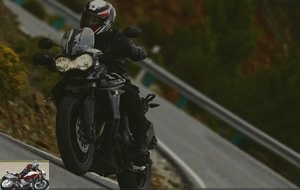
Pleasant, engine availability is one of the great qualities of these machines. In the winding, we stay in two or three, without playing the selector. From 5,000 to 10,000 revolutions / minute, the three-cylinder pushes continuously, without transition, emphasizing its raucous growl race. Road or Sport, the choice of cartography has only a slight influence on the playful character of the English women. On the other hand, the Rain mode significantly reduces its ardor by smoothing the torque curve. If some would like to see it more demonstrative, we praise the homogeneity of its mechanics.
Easy, the mounts allow corrections of trajectories on the angle and the grip of the brakes only moderately freezes the direction. Powerful and enduring, the front calipers effectively slow down the machines with, of course, a finer feel on the road version. The rear element works with vigor but can block (temporarily, ABS obliges) the wheel, during the most important mass transfers.
Convincing on asphalt, the new Triumph waders present more than ever a significant difference in their ability to exit the asphalt path. It’s the heyday of the XCx…
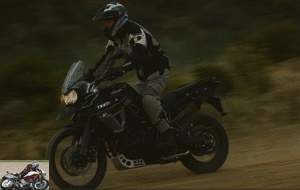
All Way
The route taken alternates wide more or less stony track, ravines and some narrower passages. Nothing infeasible with the XRx but at the risk of damaging your machine. With its dedicated suspensions prepared by WP, prepared for possible hard knocks (aluminum shoe and casing guard) the Tiger adventurer calmly approaches the tracks. It is now possible to embark on adventurous and brittle routes. While keeping in mind the high perched weight of the machine. The ergonomics, more typical all terrain, allows good support on the handlebars and adopt an effective position. The XCx fully reacts to the impulses given on the toe clips and is easily carried around. Once again, we appreciate the flexibility of the three cylinders in narrow passages..
The getaway allows you to test the "Offroad" mode, managing both engine mapping and ABS and TTC (anti-skating). Ideal for performing skids under control, the electronics effectively let the rear wheel express itself, where the "Road" setting would reduce any start to slip. Similarly, you can really load the front when braking, the anti-lock allowing a certain loss of grip. The set allows a simple and pleasant use of this Tiger. To make you regret that this "dust and stones" outing was not longer ….
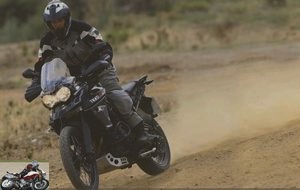
Part-cycle
XRx and XCx both benefit from a particularly successful frame / suspension pair. The first traces the road at a good pace, flying over the degraded surfaces and spinning on the best surfaces. The second adds its ability to cut across fields and an excellent feedback from its fork. Particularly well controlled, the damping is very satisfactory on both machines.
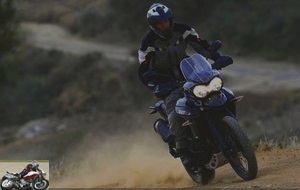
Braking
Powerful, enduring, progressive, the radial-mounted front calipers allow you to ride hard without any unpleasant surprises. However, on the most important decelerations, the transfer of masses can disturb the entry into a curve if you brake a little late. The rear clamp ideally assists the opposite retarder and the ABS, road or off-road, proves a good mastery of the electronics.

Comfort / Duo
The crew is celebrating on the backs of the Tigers. Ergonomics, equipment, suspensions…. everything contributes to his ease. In addition, with their optional luggage storage, the English will go far and long. That of the XRx, 62 L in total, accommodates an integral in the left case. Rather dedicated to the XCx, the aluminum canteen-style trunks, each weighing 37 liters, enhance the look of adventurers. A 42 L top case will complete the transport of your layette.
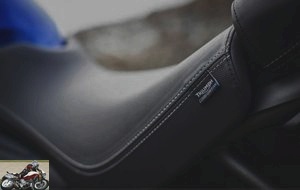
Consumption
Triumph has not made too much progress in reducing the consumption of its Tigers. They actually swallow little fuel: 6.1 L on average after 200 km at a slow pace…. And some colleagues have even done less. It is not unthinkable to achieve 5 liters per 100 with this optimized package, which, for a dynamic 800 cc is a very honorable result … thus ensuring an average autonomy of 350 to more than 400 km.

Conclusion
Evolution is good and these Tiger benefit fully. The new vintage makes them assume their difference more clearly. Already well born, these over-equipped version "x" adapt to the boiling point of their segment, optimizing their dynamic and mechanical quality. They also bring real innovations in terms of equipment and assistance. Always consensual, they will satisfy both daily and more or less distant trips. Their appealing finish and aesthetic, combined with tasty mechanics, will undoubtedly help them gain a good share of the market. Available from February 2015 and priced at 11,290 € for the XRx and 12,490 € for the XCx, the English are playing on a rather justified top of the range. The basic versions charge € 1,100 less for the XR and € 1,200 less for the XC.
All will oppose the BMW F700 GS and F800 GS, less electronic and less powerful. But no less effective, far from it, for the German 800. The first claims € 9,200, the second € 10,950 and its Adventure version € 12,250. On the Japanese side, we will mention Honda, whose VFR800X Crossrunner, € 11,999, does not display the same mechanical exuberance and cannot really manage the offroad. Another Japanese novelty to come, the Yamaha MTO9 Tracer could appeal to bikers looking for more mechanical verve, at an affordable price. Probably less than 10,000 €. The Kawasaki Versys 1000 ABS at 12 499, heavier and less versatile, will rather appeal to fans of its punchy boiler to be compared to the Suzuki VStrom 1000 at the same price. Finally, we will mention the MV Agusta Turismo Veloce and Lusso 800, haute couture stilt-walkers announced much above for € 15,000 and € 16,500. .
Tiger of the Roads or Fields, these two Triumphs are likely to mark the territory of medium-capacity trails for a long time. The most difficult will ultimately be to choose, because it will then be necessary to give up one…. or to the other.
Strong points
- Aesthetics Engine character and availability
- Relevant electronic assistance
- Comfort and convenience
Weak points
- Low speed sound
- XRx non-adjustable fork
The technical sheets of the Triumph Tiger 800 XR, XRx, XC and XCx
Colors
- Crystal white
- Phantom black
- Caspian blue
XRx Xcx equipment (table)
Other engine / technical / techno details

Accessories price
- Suitcase kit (two elements): € 790
- Comfort saddle: 219 €
- Pilot gel seat: 229.99
- Low rider gel seat: € 229.99
- Passenger gel seat: 150 €
- 20 L tank bag = 119 €
- Arrow silencer: 899 €
Related articles
-
Triumph Scrambler 1200 XC & XE test
Free spirit A dynamic leader in the neo-retro segment, Triumph draws novelty after novelty for 2019, articulated around its two twin cylinders of 900 and…
-
Comparison test Triumph Tiger 900 GT Pro and Rally Pro
Annexation of new territories 3 cylinders in line, 888 cm3, 95.2 hp, 87 Nm, 198 kg and 201 kg, euros Although the creative nation of rugby, the English…
-
A renewed proposal in a category of “mid-size” trails in full expansion …. 3 cylinders in line, 800 cm3, 95 hp at 9,500 rpm, 79 Nm at 8,050 rpm, 208…
-
A Tiger in your daily life Sporty trail, the Triumph Tiger Sport evolves with efficiency through improved mechanics and electronics and increased…
-
Triumph Trident 660 motorcycle test
Harpoon the competition 3 cylinders in line, 660 cm3, 81 hp and 64 Nm, 189 kg full made, 7,995 euros In the early 1960s, the Speed Twin was the British…
-
Lady Tri After a first static presentation in Neukirchen, during the Austrian Tri-Days, the English manufacturer is finally offering its 1200 Trophy to…
-
The English pocket knife A pendant to the road version, the Tiger 800 XC is a trail full of good surprises. Its optimized non-bitumen capacities, a very…
-
Triumph Street Triple 765 RS motorcycle test
The Moto2 roadster 3-cylinder engine, 765 cc, 123 HP, 79 Nm, 166 kg dry, € 11,900 Since its release in 2007, the Street Triple has been a real commercial…
-
Character legend Completely redesigned but faithful to its legend and its aesthetic codes, the Bonneville reinvents itself with talent and efficiency in…
-
Triumph Tiger Explorer 1200 test
A tiger with long teeth It’s no secret at Triumph, the Tiger Explorer is all about rocking the BMW R 1200 GS from its pedestal. A three-cylinder with…
Restoration of a 1992 SAMBIASE 500:
[www.facebook.com]
the engine in the photo is not that of the 500 sambiase nor even a 500RDLC engine, it is the prototype of a project of the two brothers in the mid-90s which never came to fruition: to manufacture a motorcycle 100 for 100 French (and yes, again …), chassis AND engine. This injection V4 (and direct intake into the crankcase for 4 cylinders, unlike the RDLC, the more observant of you will no doubt have noticed …) produced 130hp at the start of its development but suffered the same fate. than the Bimota V-Due of the same period.
Ah well no, the engine of the Bimota was produced, him.
With big worries, but the motorcycles have been equipped with them.
Yes, what I wanted to say is that the Sambiase project aborted for reasons that I do not know but I think that the Bimota adventure weighed in the balance because the V-due to injection, effectively marketed but unreliable , led to the brand’s first bankruptcy.
Fuck this essay yeah!
And then the callipyge rump for the FJR had to dare!!!
This is why I love motorcycles
Definitely, this last version of the FJR me downright b ** der !! Finally, the Japanese are at the height of the Teutonic brand, to make a real GT, healthy, powerful, and well equipped..
Because I consider the adjustment of the suspensions much more imperative than all the electronic trinkets that clutter the dashboards and the switchboards of the latest machines..
And it’s not nothing to go and find BMW on its own land.
The addition of a larger bubble, on which we will add the almost miraculous Givi Airflow deflector, and we will have one of the best GT in the world.
The A version disappears for France, it’s a shame, and only two colors, it’s light. So price level, we must necessarily compare with other brands while at 17,500 € there were no photos ..
So yeah you did well…
Enjoy!
I bought my first FJR 1300AE in September 2017. Fully equipped I only had to add the GPS support. It is an excellent motorcycle which is very pleasant to ride and comfortable. Good at the end of the day the buttocks sting a little after 400km but nothing serious.
As I do 12000km per year in leisure, I wanted to change it. I tried the new Versys 1000 with standard electronic assistance from Kawasaki, it’s a very good bike, but I prefer the FJR for several reasons:
– I like to go up the laps in second and third on small roads. With the Kawasaki it’s too noisy.
– in sport mode the FJR is more comfortable
– the FJR is more comfortable when driving and the mirrors more pleasant to look at
– I should have changed the bubble if I had taken the kawa because it is not very adjustable and in addition manually.
Finally Yamaha has understood everything: on the FJR there is the main part of what a motorcyclist needs: the electric bubble, the heated grips, the electronic suspensions, the cigarette lighter socket, a saddle more comfortable than a roadster, very practical suitcases, cruise control.
So I bought an FJR, the dealership took mine back in a correct way, which means that over 22 months my FJR cost me 275 € per month without maintenance for 23000km